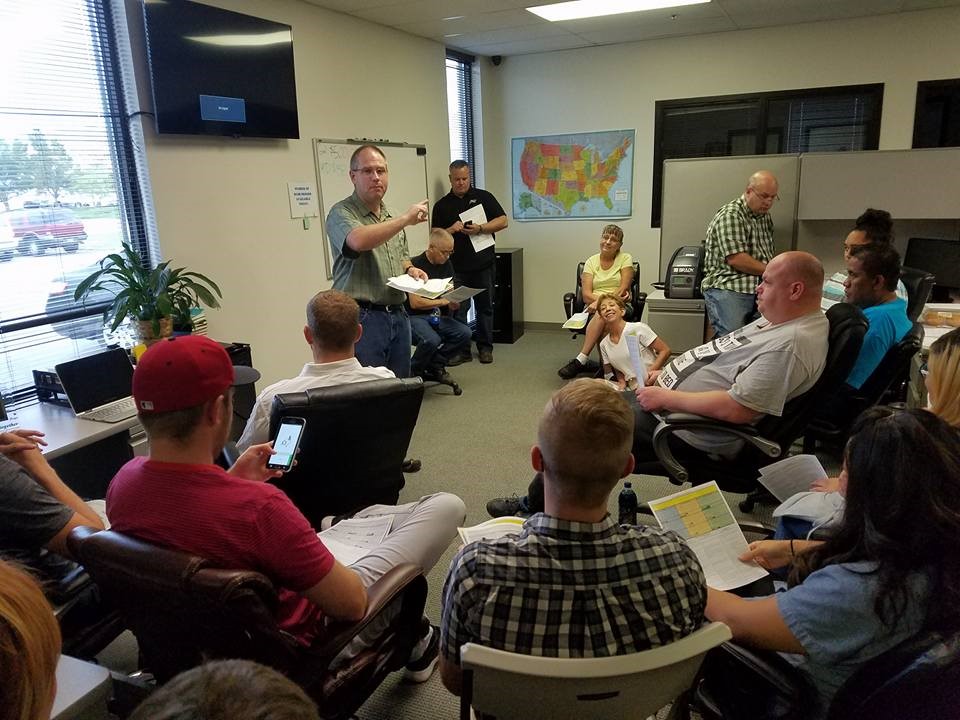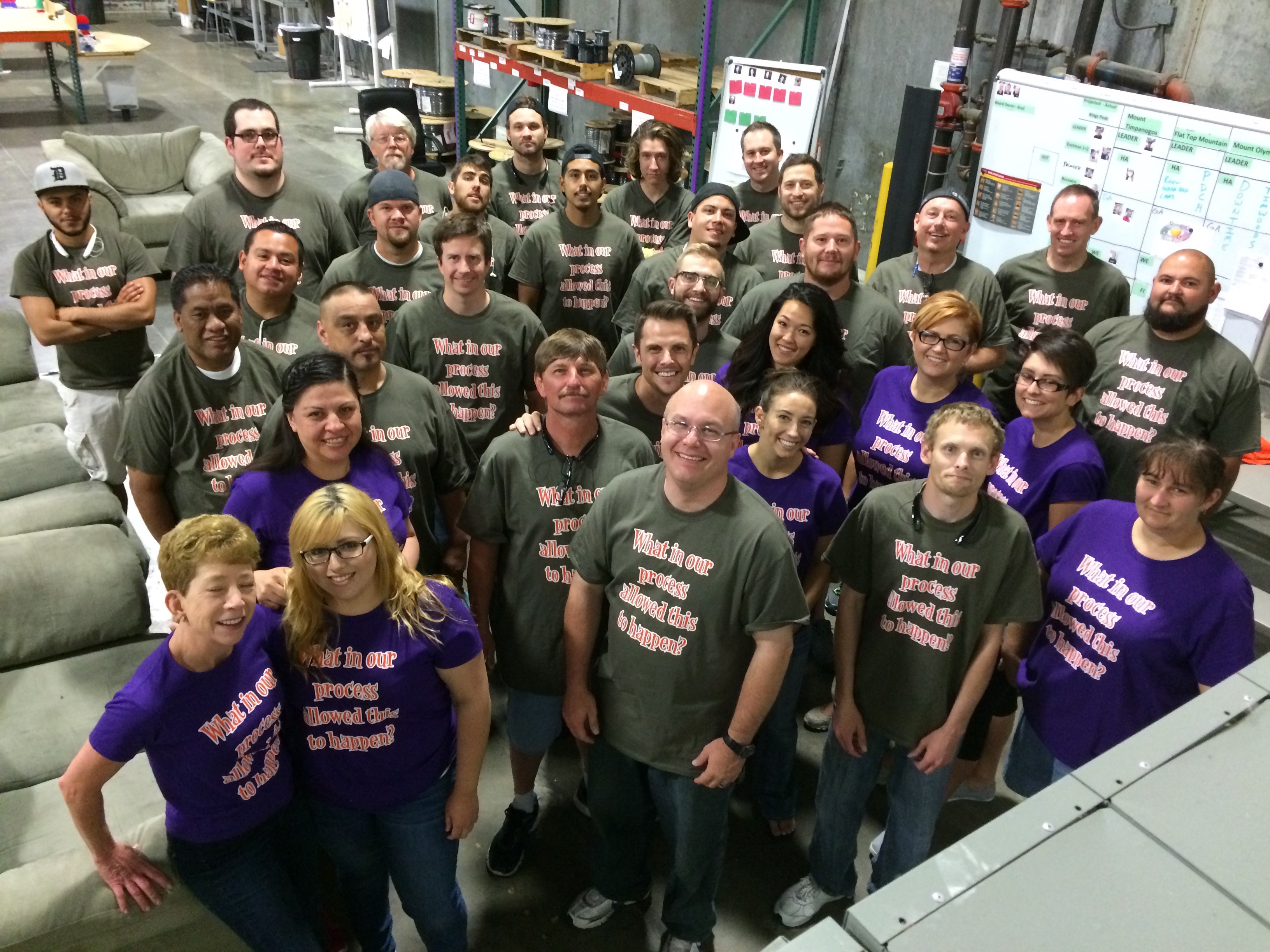by Lea Tonkin
What’s it going to take, to get to where you want to go from where you are now in your lean journey? Here’s another question: Do you really know where you stand, and do you have a clear vision of where you’re heading? Tackling these critical questions, and seeking to provide better value to customers, Salt Lake City-based Powerblanket is employing the Association for Manufacturing Excellence (AME) Lean Sensei app as a key improvement strategy.
The Lean Sensei app – a free tool available to any organization that wants to improve the way it improves – provides a framework for benchmarking against best-in-class performance reflected in AME Excellence Award recipient companies. A systematic improvement process, it fosters:
- Evaluation of current performance
- Understanding of a company’s rank against the benchmark
- Development of future improvement plans
- Review and celebration of lean journey progress.
Getting Started Powerblanket, which manufactures temperature control products ranging from drum heaters to bulk metal warmers, concrete blankets, propane tank heaters, spray foam cooling and gas cylinder heaters, began introducing lean concepts in its operations about five years ago. “We were scrambling for examples of lean progress, but didn’t have a lean consortium in our area,” said Ryan Mecham, COO. “We learned from literature and AME conferences. Two years ago, we applied for the AME Excellence Award, and then learned quite a bit from O.C. Tanner about their lean journey. Now, since its introduction, Lean Sensei became the vehicle for improvement on our lean journey. It really made a difference, when people could evaluate their lean progress, and see what excellence looks like, in safety, quality, profitability and other areas.”
Powerblanket, which manufactures temperature control products ranging from drum heaters to bulk metal warmers, concrete blankets, propane tank heaters, spray foam cooling and gas cylinder heaters, began introducing lean concepts in its operations about five years ago. “We were scrambling for examples of lean progress, but didn’t have a lean consortium in our area,” said Ryan Mecham, COO. “We learned from literature and AME conferences. Two years ago, we applied for the AME Excellence Award, and then learned quite a bit from O.C. Tanner about their lean journey. Now, since its introduction, Lean Sensei became the vehicle for improvement on our lean journey. It really made a difference, when people could evaluate their lean progress, and see what excellence looks like, in safety, quality, profitability and other areas.”
Like catchball in hoshin kanri (policy deployment), shared self-assessment and improvement planning/implementation engages people throughout the organization. “Using the Lean Sensei app helps to drive a people-centric culture,” Mecham said. “People love coming to work when they have a clear understanding of what excellence is and how they can achieve it.”
Teaming Up for Improvement
For the past couple of years, as the Lean Sensei app was being piloted by AME, Powerblanket organized its teams around the lean sensei groups. Teams such as business operations (purchasing, delivery, etc.), management systems and human//organizational development, manufacturing operations, safety and environmental health, and product development, etc. are assigned to focus on particular Lean Sensei segments. They rate current performance, set improvement targets and track progress towards identified goals.
“Our hoshin periods range from 30 to 90 days,” Mecham said, noting that approximately a third of its business is custom manufacturing. “Teams hone in on areas such as safety and quality, for example, and then, in a catchball process, they develop a proposal on where to focus improvement projects and how to measure progress toward their goals.”
At the end of each hoshin period, every team has an opportunity during a company luncheon to present their accomplishments. “This is a cycle we use to continuously update and improve,” Mecham said. “One of the advantages of being a small company (50 to 70 employees) is that we have an opportunity for everyone to get together. We discuss what it’s going to take to get from where we are now to achieving our vision (using our Lean Sensei vision statements).”
Accountability and Focus on True North
The Lean Sensei emphasis on shared accountability for improvement continuously encourages team members to focus on identifying and eliminating all forms of waste, noted Chad Meeks, a product manager and mechanical engineer. “There is a direct connection to our mission statements – focusing on true north – to delight customers, have zero injuries and 100 percent value-added activities,” he said.
Meeks developed the Powerblanket METIS (Manufacturing Engineering Technology Information System) software that enables level loading for production. Since custom products account for a third of the company’s sales, this capability is crucial. “We can determine whether we can run a product that is six hours and another at three hours, on the same line, so we can run production with one-piece flow instead of being in a batch and queue mode,” Meeks said. METIS enables Powerblanket to flexibly meet varying customer demands without carrying excess inventory. “It alerts the person doing the scheduling about whether products are incompatible on a line,” Meeks said. The data enables line leads to determine (at the beginning of a shift and throughout the day) whether they need to float people from one line or station to another.
The catchball process fosters improvements in production, and in other functional areas, according to Meeks. “People have been empowered to make improvements, and kaizens have gone through the roof, creating value and efficiency,” he said. Meeks added that Lean Sensei self-assessment and the catchball process help product managers and other teams focus on key improvement targets/resolution.
Results Powerblanket continues to build lean improvement momentum. “We’ve taken cycle time (product start to finish) from two or three days to 90 minutes, because of one-piece flow, and on some products, we’re down to 45 minutes,” Mecham said. “Our on-time delivery increased from 67.8 percent to 97.5 percent. Returned materials decreased from 3.3 percent to less than one quarter of one percent.” Meanwhile, the company’s scrap rate decreased from 1.6 percent to 0.6 percent. Finished inventory turns rose six-fold during the past five years, with a 75 percent improvement during the past year. A corresponding “dramatic” profitability improvement is reported by Mecham for the privately-held company.
Powerblanket continues to build lean improvement momentum. “We’ve taken cycle time (product start to finish) from two or three days to 90 minutes, because of one-piece flow, and on some products, we’re down to 45 minutes,” Mecham said. “Our on-time delivery increased from 67.8 percent to 97.5 percent. Returned materials decreased from 3.3 percent to less than one quarter of one percent.” Meanwhile, the company’s scrap rate decreased from 1.6 percent to 0.6 percent. Finished inventory turns rose six-fold during the past five years, with a 75 percent improvement during the past year. A corresponding “dramatic” profitability improvement is reported by Mecham for the privately-held company.
“Because of our lean processes, we’ve been able to dominate custom markets for our products,” Mecham said. “We can get a custom order in, design it, build it, and ship within three days. Previously, we couldn’t take on a custom job and ship in less than four to six weeks.”
Powerblanket’s Net Promoter Score (NPS) ratings also continue to improve. “With every order, we email a link to NPS, and we look at those scores on a weekly basis; it’s a big deal to us,” Mecham said.
Lessons Learned
Mecham believes that the Lean Sensei app can be successfully employed in small or large companies, helping to systematically drive measurable improvements. “Just get started with Lean Sensei, and get a vision of where you can go,” he counseled. “And join AME, so you can talk with others who have done it. If you can organize around Lean Sensei – making issues visible and involving teams in needed improvements – you can improve delivery, cost and other areas, as you develop more of a people-centric culture.”
Progress never stops on the lean journey at Powerblanket. “That’s what so fun about it,” Mecham said. “There are always things to improve.”
Additional resources suggested by Mecham: “Everybody Matters; The Extraordinary Power of Caring for Your People Like Family” by Bob Chapman; “Own the Gap” by Bryan Crowell and Mike Martyn; and Dennis Pascal’s “Lean Production Simplified.”
Lea Tonkin is the president of Lea Tonkin Communications, Woodstock, IL.
For more information about the AME Lean Sensei app and Excel tool, including a link to download, be sure to visit the AME Lean Sensei webpage. You can learn from the experts who helped pioneer AME Lean Sensei at the AME 2017 International Conference in Boston. Visit ame.org/Boston for more information!
Stay up-to-date on all things AME, join our mailing list!


